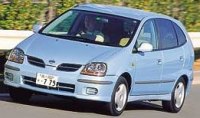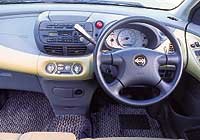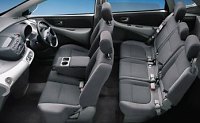 When
Nissan's designers in Brussel studio penned the Tino MPV based on the
inspiration
from Renault Scenic, they didn't know the Japanese no. 2 car maker
would
be taken over by Renault sometime later. Now the merger has been fully
effective. Tino has also gone on sale in most European countries
including
France. Would they regret making the Tino so look-alike to the Scenic
and
created internal competition? When
Nissan's designers in Brussel studio penned the Tino MPV based on the
inspiration
from Renault Scenic, they didn't know the Japanese no. 2 car maker
would
be taken over by Renault sometime later. Now the merger has been fully
effective. Tino has also gone on sale in most European countries
including
France. Would they regret making the Tino so look-alike to the Scenic
and
created internal competition?
Calling the Tino an imitator is never far away from the truth. Look at the exterior ... that profile, those dimenisions, that windscreen, those side windows, even the headlamps look similar to the newly facelifed Scenic (although Tino actually appeared in Japan earlier than the phase II Scenic). If there were patent right for styling in motor industry, Renault would have taken legal action.
Perhaps not all. Tino's dashboard is completely original, and what's more, it looks great. Swoopy, futuristic, bright and multi-tone color scheme make the dash one of the most distinctive one currently available in vehicles of any kind. Beside the funny white dials is a bubble-shape instrument panel. Sat navigation screen is recessed under the top surface of the bubble. It pops up like a supercar's headlamp. Where's the shifter? Nissan placed it at the steering column in order to eliminate the transmission tunnel, thus between the front seats they can install an extra tiny cushion and backrest for accommodating a child. It's not Multipla-generous, just barely a 5+1 seating plan. Whenever the child seat is not in use, the small backrest can be folded down to form an arm rest.
Now come the dynamic aspect. Tino is built directly on Sunny / Almera / Sentra's floorpan, so it handles nearly as competent as most family hatchbacks. Ride from the multi-link beam axle rear suspension is very comfortable, while roll control is also good. Two engines are offered - top model has Primera's 2-litre 16v with 135 horsepower, mated exclusively with a CVT. Another version has Almera's 1.8-litre 16v, but the torquey 2-litre engine is favourable to cope with the heavy body. CVT is smooth and responsive. Judging
objectively, Tino
probably edge out the master Scenic by its more thoughtful interior
layout
and better visual desirability. The dashboard is overwhelmingly
superior.
The exterior finish is marginally better, thanks to the stylish lip
spoiler
and skirts fitted. Reliability is also hard to be challenged,
especially
is the domestic built cars (European Tino is built in Spain). However,
the pupil lost a lot of subjective marks because of the lack of
originality.
After all, both Scenic and Tino are not as complete as our
class-leaders
Multipla and Picasso. |
| The above report was last updated on 11 Apr 2000. All Rights Reserved. |
 Now
explore the interior ... those 5 individual seats are independently
removable,
the center one can be folded down to become a table with twin cup
holders
... all rear seats fold forward to enable a large cargo area ...
clearly
enough, everything is copied from Scenic.
Now
explore the interior ... those 5 individual seats are independently
removable,
the center one can be folded down to become a table with twin cup
holders
... all rear seats fold forward to enable a large cargo area ...
clearly
enough, everything is copied from Scenic.  Another
thing the pupil cleverer than the master is the 4-seater plan. Tino's
rear
passenger room is very tight owing to its 2535 mm wheelbase, which is
the
shortest among all 5-seater MPV. If there is only 4 people on board,
more
rear legroom can be obtained by removing the center rear seat, pushing
the remaining two chairs closer together, then they could be slid
backwards
without being obstructed by the wheelarches. On the contrary, slide
forward
enable greater boot volume.
Another
thing the pupil cleverer than the master is the 4-seater plan. Tino's
rear
passenger room is very tight owing to its 2535 mm wheelbase, which is
the
shortest among all 5-seater MPV. If there is only 4 people on board,
more
rear legroom can be obtained by removing the center rear seat, pushing
the remaining two chairs closer together, then they could be slid
backwards
without being obstructed by the wheelarches. On the contrary, slide
forward
enable greater boot volume.